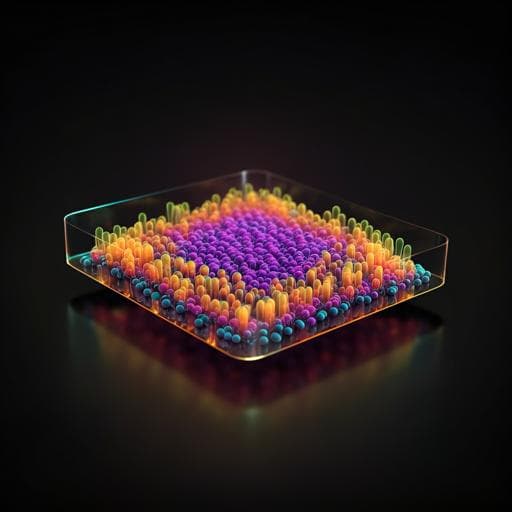
Engineering and Technology
A polymeric piezoelectric MEMS accelerometer with high sensitivity, low noise density, and an innovative manufacturing approach
C. Ge and E. Cretu
Discover groundbreaking advancements in sensor technology with this innovative polymer piezoelectric MEMS accelerometer design by Chang Ge and Edmond Cretu. Utilizing state-of-the-art fabrication techniques, this device not only achieves impressive sensitivity but also outperforms traditional counterparts in size and noise performance.
~3 min • Beginner • English
Introduction
Microelectromechanical system (MEMS) accelerometers detect mechanical acceleration through alterations in electrical capacitance (capacitive), resistance (piezoresistive), or charge (piezoelectric) as occurs within miniaturized structures. They rank second in usage among MEMS devices, with only pressure sensors being more commonly used1. While traditionally used for vibration monitoring2,3, automotive testing2,3, and inertial navigation4, recent research highlights the potential of MEMS accelerometers in health monitoring devices and implantable hearing aids5-7. Early MEMS accelerometers used piezoresistive coupling in silicon. Advances in silicon micromachining enabled the robust fabrication of more intricate movable micromechanical structures, leading to capacitive accelerometers with comb drives. Piezoelectric MEMS accelerometers have therefore become popular of late. They provide many advantages over piezoresistive and capacitive couplings, such as higher temperature stability, higher robustness, reduced power consumption, better linear characteristics, wider dynamic range, enhanced sensitivity, and no vacuum sealing requirement1-10. Additionally, when used for implantable hearing aids, piezoelectric accelerometers have the potential to directly interface with neurons, eliminating the need for extra readout circuits5-7.
Despite their diverse advantages, piezoelectric MEMS accelerometers face a tradeoff of environmental exposure risks versus performance. For example, high-performance piezoelectric materials such as lead zirconate titanate (PZT) raise ecological concerns related to heavy
Ge and Cretu Microsystems & Nanoengineering (2023)9:151 Page 2 of 16
metals11–14. Lead-free high-performance alternatives such as potassium sodium niobate (KNN) present sustainability-related issues during raw material excavation11,12. Even though more environmentally friendly materials such as aluminum nitrides (AIN)5,7,15,16 and zinc oxide (ZnO)6,13,14,17 can be used for piezoelectric MEMS transducers, they cannot provide device performance comparable with PZT-based MEMS transducers due to weaker piezoelectric properties. Moreover, all these inorganic materials, regardless of their piezoelectric properties and environmental impacts, are used in MEMS fabrication flow based on similar methodologies. Being either bottom-to-top surface micromachinings or top-to-bottom bulk micromachinings4,8,10,13–15, these microfabrication flows all inevitably repeat the three-step cycle of material deposition, masking lithography, and anisotropic etching, leading to almost identical process complexity. If a design opts for reduced performance for environmental benefits, then a simpler fabrication process should at least be expected to make the tradeoff worthwhile.
A viable approach to address the aforementioned challenges is the development of polymeric piezoelectric MEMS devices utilizing poly(vinyl fluoride) (PVDF) films. First, PVDF has higher piezoelectric coefficients than ZnO and AIN1, laying the foundation for potentially higher-performing devices. Additionally, PVDF films can be directly shaped into microstructures through advanced methods such as laser micromachining and additive manufacturing, bypassing traditional three-step cycles to streamline fabrication flows.
In addition to simultaneously achieving simple, environmentally friendly microfabrication flows that yield high sensitivity devices, polymeric piezoelectric MEMS accelerometers based on PVDF can also make a more solid foothold for MEMS inertial sensors in the emerging field of flexible electronic microsystems, giving extra significance to the research of these polymer MEMS devices. Leveraging the constant advances in semiconducting organic materials and organic field effect transistors19, research interest in full-polymer electronic systems featuring polymer sensors and polymer integrated circuits continues to rise, causing an increased demand for polymeric MEMS sensors as the vital front end for information collection and fueling the corresponding research. For example, tactile sensors, as the polymeric subcategory of MEMS pressure sensors, have been extensively studied, enabling diverse novel applications of this most widely used MEMS type, such as intelligent skins and soft robots20.
In contrast, research on developing polymer versions of MEMS inertial sensors, which are the second most-often used MEMS type, is less mature. Moreover, the few existing studies on high-performance, polymeric, piezoelectric MEMS accelerometers lean toward adapting energy harvesters as accelerometers21–23. MEMS energy harvesters are tuned to work around their mechanical resonant frequency, taking advantage of the corresponding most significant mechanical response. In contrast, MEMS accelerometers work on a flat band leftwards to their mechanical resonant peak. Compared to conventional MEMS accelerometers, the alternatives converted from MEMS energy harvesters have a confined bandwidth, limiting their application potential. To address this long-standing limitation, further research on polymeric conventional piezoelectric MEMS accelerometers remains necessary.
In this context, a new design for PVDF-based piezoelectric MEMS accelerometers is proposed. Three samples were fabricated using a simplified polymer-based microfabrication technology. These samples were characterized for their mechanical resonant characteristics, frequency response, flat band sensitivity to input accelerations, and device-level noises. A comparison between the experimental measurements and benchmarks indicates promising performance. Following this introduction, subsequent sections discuss the device design, test results, benchmark comparison, fabrication flow, and experimental setup. The paper concludes by summarizing the present study’s significance and future potential.
Literature Review
Methodology
The study proposes and validates a PVDF-based piezoelectric MEMS accelerometer designed for high sensitivity with a simplified, polymer-focused fabrication approach. Key elements:
- Theoretical basis: Sensitivity derived from direct piezoelectric effect with emphasis on maximizing the stress difference between top and bottom surfaces of the piezoelectric layer and leveraging a thicker piezoelectric layer to enhance charge output while maintaining a suitable resonant frequency. The analysis links output charge to piezoelectric coefficient d31, stress distribution, piezoelectric layer thickness H, and dielectric constant ε.
- Device architecture: Each accelerometer comprises six identical cantilever-based sensing units electrically connected in parallel to sum their outputs, reducing the need for extra electrode patterning on the PVDF layer and lowering transverse coupling.
- Materials and layers: PVDF piezoelectric layer thickness 100 µm; polyimide mechanical layer thickness 75 µm; bottom electrode interconnect layer composed of 35 µm polyimide + 25 µm copper (Cu); 3D-printed inertial mass (rigid 10 K resin). The multilayer stack is assembled from four separately fabricated polymeric components via alignment vias that also expose electrode surfaces for interconnection.
- Geometry for low resonant frequency and high sensitivity: PVDF cantilever length 7.5 mm and width 2 mm; polyimide cantilever width 300 µm. The design emphasizes a relatively large inertial mass and compliant beams to reduce the equivalent spring constant and resonant frequency, thereby boosting sensitivity. Vias are included for alignment and electrode access; polyimide is partially removed to expose Cu connected to the bottom electrode.
- Simulation: COMSOL finite element analysis predicts a fundamental resonant frequency of approximately 126.46 Hz for a single cantilever sensing unit. Stress simulations under 2 g input show tensile stress on the PVDF top surface and compressive stress on the bottom surface, consistent with cantilever bending; the neutral axis lies within the PVDF layer, closer to the top surface.
- Fabrication approach: Simplified polymer microfabrication leveraging direct material processing: laser micromachining of thin films (PVDF, polyimide/Cu) to define cantilevers, vias, and exposed copper areas; 3D stereolithography to print inertial masses; assembly via alignment features; electrical access via exposed top and bottom electrodes through vias and connection to customized PCB using silver paste. Optical inspections confirm clean laser machining on copper, precise alignment between layers, and clear exposure of copper through polyimide.
- Prototypes: Three samples were fabricated and packaged on PCB for testing. Mechanical resonance characterization was performed to extract fundamental resonant frequencies and quality factors as a basis for subsequent accelerometer performance evaluation.
Key Findings
- Achieved sensitivity: 21.82 pC/g (equivalent open-circuit voltage sensitivity: 126.32 mV/g).
- Flat band: 5% flat band of 58.5 Hz.
- Noise density: 6.02 µg/v/Hz.
- Performance comparison: Rivals state-of-the-art PZT-based counterparts in charge sensitivity and noise density; surpasses several commercial MEMS accelerometers.
- Size/bandwidth advantage over prior organic devices: 10× smaller device area and 4× larger flat band than previous state-of-the-art organic piezoelectric MEMS accelerometers.
- Simulated resonant frequency for a single sensing unit: ~126.46 Hz; stress distribution confirms design intent with tensile top and compressive bottom surfaces on PVDF under acceleration.
Discussion
Conclusion
Limitations
Related Publications
Explore these studies to deepen your understanding of the subject.







